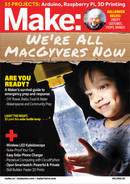
PROJECTS: Wireless LED Kaleidoscope
only slightly or not at all.
Once you’re certain the electronics work
properly, unplug the USB cable from the power
source and set the transmitting coil to one side
while you attach the LED compartment to the
kaleidoscope in the next step.
6. ASSEMBLE THE LED COMPARTMENT
The powered LEDs will shine brightest when
facing directly upward into the kaleidoscope, so
we’ll place them inside tiny clear acrylic “collars”
that maintain their orientation as they slide
around (Figure
S
). Be sure that you’ve removed
any protective paper from the acrylic rings before
carefully slipping the LEDs into them. The LEDs
should slide easily into the rings. Do not apply
pressure to force them in. If the rings seem too
small for your LEDs, laser cut another set of
rings with a slightly larger inner hole. The LEDs
and their collars are easily misplaced, so put
them in a small container and set them aside for
the moment.
To attach the LED compartment, set the
kaleidoscope vertically onto its eyepiece with
circle C visible on top. Remove the three M3
screws that hold layers A, B, and C together.
Carefully put an acrylic collar around each LED,
then place each assembly on top of the clear
acrylic triangle with its LED facing downward into
the kaleidoscope (Figure
T
). Once all the LEDs
have been placed, stack circle D on top of circle
C so that the LEDs sit inside the triangular holes
in both layers C and D. Next, place circle E on top
of D, lining up the screw holes in all five lettered
layers. Reinsert the M3 screws into their holes
so the screw heads rest on top of layer E. Secure
the screws underneath layer A with the M3 nuts.
Now, when you move the kaleidoscope, the LEDs
are free to slide around, but their collars keep the
LEDs always pointed toward the viewer.
Your wireless LED kaleidoscope is now
complete!
GO WITH THE GLOW
To use your shiny new kaleidoscope:
• Power the transmitter by plugging the USB
cable into a 5V source.
• Set the end of the kaleidoscope with the LED
compartment into the transmitter case to
generate power for the LEDs.
• Look through the eyepiece to see the
symmetric shapes created by the infinite
reflections of colorful LEDs!
To create new visual patterns, tilt and rotate the
kaleidoscope within the transmitter base to move
the LEDs around (Figures
U
and
V
).
BRIGHT IDEAS FOR FURTHER EXPLORATION
To take this project a step further, you might try
adding reflective beads or rhinestones into the
container along with the LEDs. Choose objects that
won’t catch on the small acrylic rings. Or try laser-
cutting new collars of different shapes and colors
to place around the LEDs. Or make the project
portable with a small 5V phone power bank.
ALTERNATIVE MATERIALS
You can easily change the appearance of this
build by cutting the frame from an alternative
sheet material and selecting a different color of
adhesive vinyl. Figure
W
shows a kaleidoscope I
created with a clear acrylic frame and a striped
holographic vinyl backing on the mirrors.
S T
66 makezine.com
M82_060-67_Kaleidoscope_F1.indd 66M82_060-67_Kaleidoscope_F1.indd 66 7/11/22 3:08 PM7/11/22 3:08 PM
..................Content has been hidden....................
You can't read the all page of ebook, please click here login for view all page.
